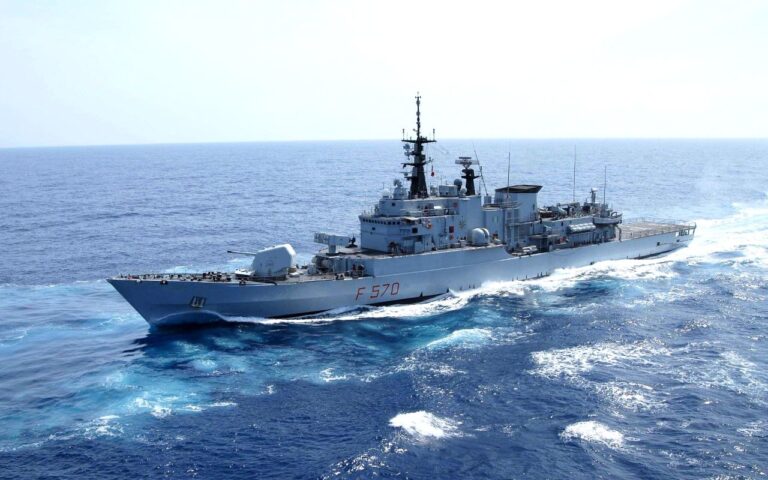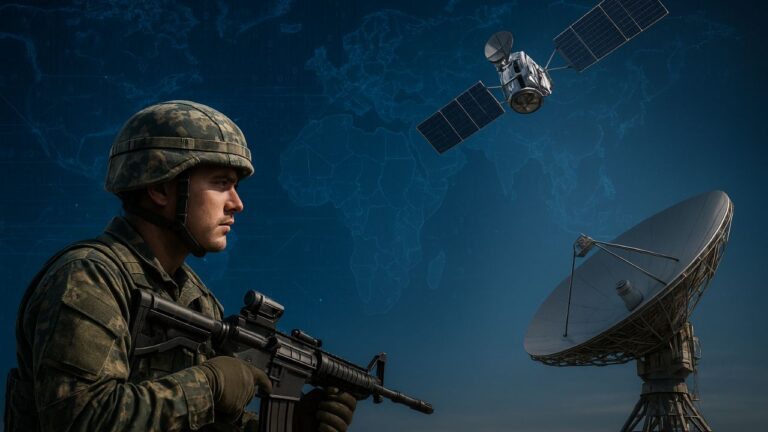
The Indian Air Force (IAF) has long been a keystone of India’s national security architecture. Facing complex threats across borders, challenging terrain, and evolving domains of warfare, the IAF is in a transformative phase. With the retirement of legacy platforms and growing emphasis on indigenous development, networked operations, and multi-domain integration, the IAF’s modernization is central to India’s objective of becoming a credible aerospace power.
This article examines the current capabilities of the IAF, major modernization efforts, enabling technologies, operational doctrine, challenges, and the road ahead.
Current Capabilities & Force Structure
Squadron Strength & Fleet Composition
- Though authorized squadron strength for the IAF has been around 42 squadrons, actual squadron strength has dropped significantly due to retirements and delays in new inductions.
- The fleet includes a mix of advanced combat aircraft—Su-30MKI, Rafale, Mirage-2000, MiG-29, and the indigenous Tejas LCA. Many older types have been or are being phased out (e.g., MiG-21).
Force Enablers & Support Assets
- Airborne Early Warning & Control (AEW&C) systems are critical for India’s situational awareness. Projects like Netra Mk II are being developed to expand long-range surveillance coverage.
- Transport & helicopter fleets have improved with induction of platforms like C-130J special operations transports, Mi-17V5 medium lift helicopters, and CH-47F/Apache helicopters for attack/lift roles.
Weapon Systems / Strike Capability
- Indigenous weapons like the Smart Anti-Airfield Weapon (SAAW) allow IAF aircraft to neutralize key enemy infrastructure, such as runways, from stand-off distances.
- Surface-to-air missile systems (e.g., Akash, MR-SAM), medium and long-range air defence, are being upgraded to provide layered defensive capability. For example, Project Kusha aims to cover medium ranges.
Operational Roles & Experience
- The IAF plays a broad spectrum of roles: air superiority, ground attack, reconnaissance/intelligence, counter-insurgency, disaster relief, and logistical support in remote regions. It also engages in frequent joint exercises and operations to maintain combat readiness.
Indian Air Force: Major Modernization Initiatives
Indigenous Aircraft Development
- The LCA Tejas Mk 1A is being inducted with AESA radar, modern avionics, and improved weapons integration. It is aimed at replacing older fighters and bolstering squadron strength.
- The Advanced Medium Combat Aircraft (AMCA) project is underway as India’s future fifth-generation stealth fighter. It represents a long-term indigenous development effort.
Upgrades to Existing Fleet
- Su-30MKI upgrades (“Super Sukhoi”) are being designed to enhance radar, avionics, sensors, and weapons platforms to extend service life and capability.
- Mirage-2000s and other legacy platforms are likewise receiving avionics, weapon, radar upgrades to ensure relevance in modern combat environments.
Force Transparency and Early Warning
- The Netra Mk II AEW&C project has been approved (≈ ₹20,000 crore) to improve airborne surveillance and control. These platforms will help detect threats at long ranges and enable better battle management.
High-Level Planning & Private Sector Role
- A government committee has laid out a “glide path” for accelerated capability enhancement, targeting gaps in squadron strength, force enablers, and private sector participation in defense aircraft production.
- Private defence firms are increasingly being involved in manufacturing efforts to support HAL and DRDO, to speed up deliveries and build stronger indigenous capacity.
Operational Doctrine & Strategic Vision
Shift to Capability-Based & Network Centric Warfare
- The IAF is moving away from platform-centric thinking toward capability-based operations. This involves having multi-role aircraft, versatile weapons, and systems that can be quickly reconfigured for air superiority, strike, or interdiction. Networked sensors, AEW&C, satellites, and real-time data links are central to this.
Multi-Domain Integration
- Doctrine and strategic documents released lately emphasize integration among air, space, cyber, and information domains. The Technology Perspective & Capability Roadmap (TPCR) and the Multi-Domain Operations (MDO) doctrine aim to formalize this approach across the Indian Armed Forces.
Quick Reaction & Air Defence
- With threats from cross-border ballistic/cruise missiles, drone incursions, and potential adversary air force actions, the IAF continues to maintain and upgrade its regional air defence posture. Surface-to-air missile systems, integrated command & control systems (like IACCS) and radar networks are being expanded.
Key Challenges and Gaps
Squadron Strength Shortfall
- The authorized strength (≈ 42 squadrons) is not currently met; various reports suggest IAF operates with ~30-35 squadrons depending on retirements and delayed inductions. Maintaining numbers is a critical concern given two-front threats.
Delays in Indigenization and Production
- Development timelines for AMCA, Tejas production, engine supplies (especially foreign components), and other enabling technologies have seen delays. Cadence of delivery is lower than required.
Technology Gaps
- Some areas still remain weak: indigenous engine capability remains limited, high-end sensors and EW/SEAD systems are catching up, space and counter-space capabilities are nascent.
- Logistics, maintenance, spare parts, and upgrade of older aircraft are resource and time consuming.
Budgetary & Procurement Bottlenecks
- While defence budgets are significant, competing demands (manpower, pensions, maintenance) often absorb large portions. Procurement processes are gradually being streamlined but bureaucratic delays still affect timelines.
Training & Human Resources
- Transitioning to high-technology platforms requires modern training, simulators, maintenance crews with high skills, and retention of technical personnel. Simulation infrastructure and operator training remain critical areas.
Strategic Implications & Regional Context
- Two-Front Threats: With China in the North East and Pakistan in the West, air superiority and quick response matter significantly. Gaps in squadron strength or delays in modernization can tilt dynamics.
- Emerging Domains: China and Pakistan are improving their own AWACS, UAVs/UCAVs, cruise/hypersonic missile capabilities. India must match pace to avoid strategic surprise.
- Export & Diplomacy: Successful indigenous systems like Tejas, SAAW, possibly AMCA in future, can contribute to defence exports and build diplomatic influence with friendly nations seeking cost-effective aircraft/air defence solutions.
- Force Multipliers & Deterrence: AEW&C, counter-air defence, standoff weapons (glide bombs, missiles), integrated data networks act as force multipliers, helping offset numerical disadvantage.
Road Ahead: Strategic Priorities
- Accelerate Tejas & AMCA Production & Certification
Ensuring timely deliveries of Tejas Mk1A & Mk2, completing certification and capability maturation, and making AMCA ready with stealth, sensor fusion, internal weapons bays etc. - Indigenous Engine & Sensor Development
Boost development of high-performance engines (turbojet/turbofan), AESA radars, EW/SEAD suites. Reduce reliance on imported subsystems. - Expand AEW&C / ISTAR Assets
Bring Netra Mk II into service; acquire / upgrade ISTAR (Intelligence, Surveillance, Targeting, Reconnaissance) platforms to cover threat detection, forward warning and decision-making. - Strengthen Air Defence & Rapid Reaction Forces
Deploy more missile defence systems, counter-drone tools, and ensure readiness of air bases, runway infrastructure, and rapid mobilization for crises. - Joint & Networked Doctrine Implementation
Deepen capability integration among all domains (air, space, cyber), ensure common data links and AI/ML tools for decision support. Roll out joint doctrines (MDO, JTAC etc.) effectively, use exercises to practice coordination. - Private Sector & Supply Chain Boost
Encourage private companies to partner in manufacturing, maintenance, and innovation. Improve supply chain resilience especially for composites, avionics, sensors. - Training, Simulation & Maintenance Infrastructure
Build high-fidelity simulators, expand pilot/crew training in high-threat, multi-domain environments. Upgrade maintenance depots, ensure spare parts availability.
Conclusion
The Indian Air Force is undergoing a paradigm shift—phasing out legacy aircraft, embracing indigenous platforms, beefing up surveillance and force enablers, and moving toward multi-domain operational doctrines. The modernization efforts underway—Tejas Mk1A/AMCA, Netra Mk II, upgrades to Su-30MKI, increased private sector participation—are steps toward achieving an aerospace force capable of meeting future threats.
However, critical gaps remain: squadron strength, production delays, technology/engine dependency, and training resources. Addressing these with urgency is essential, especially in a region where adversaries are rapidly modernizing.
If India successfully bridges these gaps, the IAF will not only secure the skies but also contribute significantly to deterrence, regional stability, and national prestige. The trajectory is promising — the challenge is in execution.






